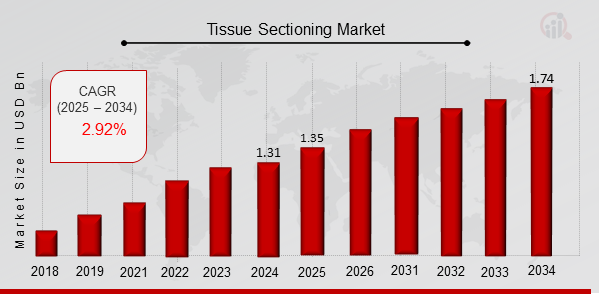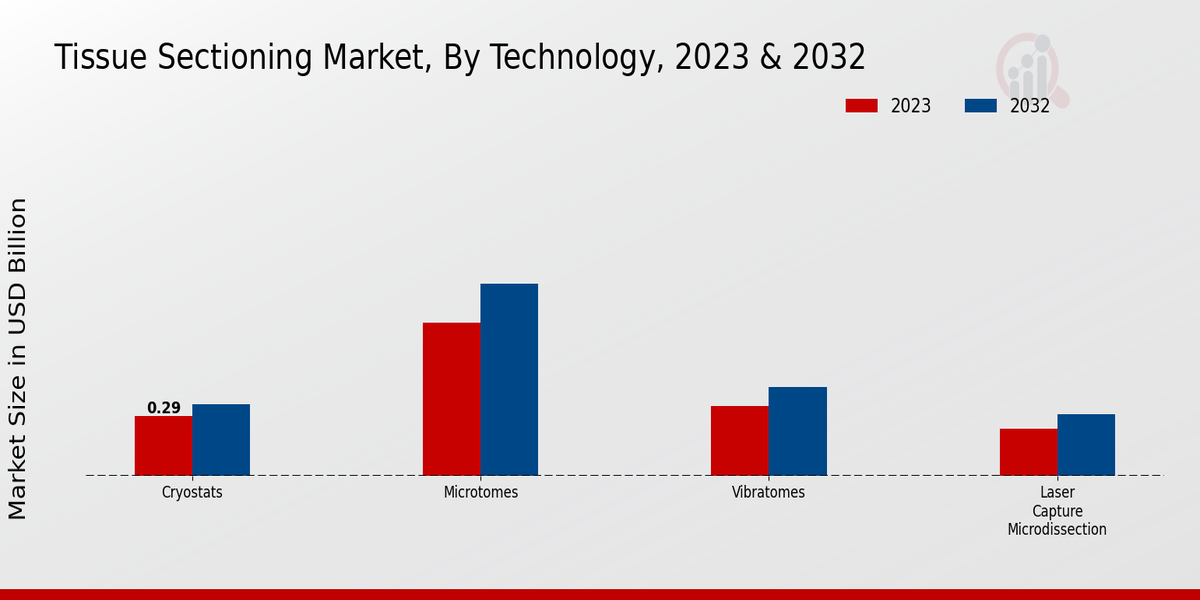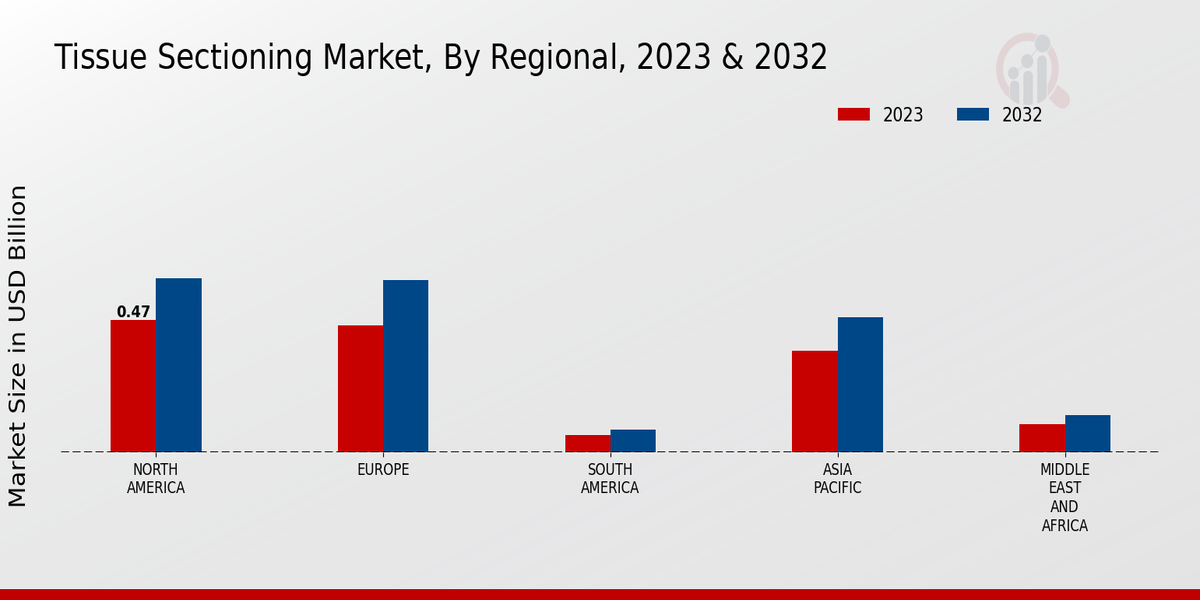Tissue Sectioning Market Overview
As per MRFR analysis, the Tissue Sectioning Market Size was estimated at 1.31 (USD Billion) in 2024. The Tissue Sectioning Market Industry is expected to grow from 1.35 (USD Billion) in 2025 to 1.74 (USD Billion) till 2034, at a CAGR (growth rate) is expected to be around 2.92% during the forecast period (2025 - 2034).
Key Tissue Sectioning Market Trends Highlighted
Key market drivers for the Tissue Sectioning Market include the rising prevalence of chronic diseases, increasing demand for personalized medicine, and technological advancements in tissue sectioning techniques.
Opportunities lie in the development of new technologies, such as laser-based sectioning, and the expansion of applications in fields such as neuropathology and cancer research.
Recent trends include the adoption of artificial intelligence (AI) for automated tissue sectioning, the development of integrated systems for tissue preparation, and the focus on miniaturization and portability of tissue sectioning devices. Key players in the market are investing in research and development to improve sectioning accuracy, speed, and efficiency.
The growing demand for precision and reproducibility in tissue sectioning drives the need for advanced technologies and innovative solutions. Manufacturers are responding to this demand by developing new products and services that meet the specific requirements of different research and diagnostic applications.

Source: Primary Research, Secondary Research, MRFR Database and Analyst Review
Tissue Sectioning Market Drivers
Increasing Demand for Tissue Sectioning in Cancer Diagnosis and Research
The global prevalence of cancer in people is on the rise on a global scale, which is driving the Global Tissue Sectioning Market Industry. In cancer diagnostics, tissue sectioning plays an integral role in diagnosing and classifying different types of cancers, such as breast, lung, and prostate cancers.
It involves obtaining a thin sample of tissue or cells and examining it under a microscope to determine whether the tissue is normal or abnormal and diagnose the stage and type of cancer.
Moreover, the demand for cancer diagnostics and the rising trend of personalized medicine are other key factors that are fueling the growth of Tissue Sectioning Market Industry.
Advancements in Tissue Sectioning Technology
The growth of the Global Tissue Sectioning Market Industry is driven by technological advancements. Automated tissue sectioning systems have been introduced, which are revolutionizing the process of tissue sectioning. These systems are based on advanced imaging techniques and software algorithms.
The use of such systems eliminates the risk of human errors and ensures consistent, accurate, high-quality sections. Moreover, novel tissue staining techniques and reagents are being developed, which offer new opportunities for the visualization of tissue samples and analysis of data.
Growing Adoption of Tissue Sectioning in Non-Medical Applications
Apart from the traditional use of tissue sectioning in the field of medical diagnostics, utilizing this technology in non-medical applications is also emerging and driving the market's growth. Tissue sectioning is increasingly being used in the areas of agricultural research, environmental monitoring, and materials science, opening up additional market opportunities.
In agricultural research, plant scientists use tissue sectioning to examine plant anatomy and physiology; this, in turn, is essential for breeding new crop varieties and determining how plants respond to various environmental factors.
In materials science, tissue sectioning is used to analyze the composition and microstructure of materials produced by materials engineers.
Tissue Sectioning Market Segment Insights:
Tissue Sectioning Market Technology Insights
The Global Tissue Sectioning Market is segmented based on Technology into Microtomes, Cryostats, Vibratomes, and Laser Capture Microdissection. Microtomes are used to cut thin sections of biological tissue for examination under a microscope. They are widely used in histology, pathology, and other fields of biomedical research.
They are commonly used in histology, pathology, and other fields of biomedical research. They are commonly used in neuroscience, developmental biology, and other fields of biomedical research. The global vibratome market is expected to reach USD 1.23 billion by 2032, growing at a CAGR of 2.92% from 2024 to 2032.
Laser Capture Microdissection (LCM) is a technique used to isolate specific cells or regions of tissue from a sample. LCM is commonly used in molecular biology, genomics, and other fields of biomedical research.

Source: Primary Research, Secondary Research, MRFR Database and Analyst Review
Tissue Sectioning Market Application Insights
The Global Tissue Sectioning Market Segmentation by Application can be deciphered as Histopathology, Neuropathology, Pharmacology, Developmental Biology, and Forensic Science. The Histopathology segment accounted for the largest market share in 2023, and it was more than 60% of the revenue.
The growth of the segment can be attributed to an increased prevalence of cancer and other chronic diseases. The Neuropathology segment is also a major application segment, and in 2023, its share was more than 25%.
The growth of the segment is fueled by the rising incidence of neurological disorders. The Pharmacology and Developmental Biology segments are also significant, and their shares are equal to circa 5% and 3%, respectively.
The growth of these segments is conditioned by the increasing use of tissue sectioning in drug discovery and in research. Finally, the Forensic Science segment was a niche one, with the 2023 share of less than one percent. Still, further growth of the service can be expected because of the increasing use of tissue sectioning in order to solve crimes and conduct forensic analysis.
Tissue Sectioning Market Specimen Type Insights
The Global Tissue Sectioning Market is segmented by Specimen Type into Tissues, Cells, Organs, and Embryos. Among these, the Tissues segment held the largest market share in 2023 and is expected to continue its dominance throughout the forecast period.
This is primarily attributed to the increasing demand for tissue biopsies in various medical applications, including cancer diagnosis, disease research, and drug development. The Cells segment is also expected to witness significant growth, driven by the rising adoption of cell-based therapies and regenerative medicine.
Organs and Embryos segments are anticipated to contribute moderately to the overall market growth, owing to their specialized applications in research and transplantation procedures.
Tissue Sectioning Market End User Insights
The end-user segment of the Global Tissue Sectioning Market is categorized into hospitals, laboratories, research institutes, and universities. Hospitals hold the largest market share due to the high demand for tissue sectioning in histopathology and surgical procedures.
In 2023, the Global Tissue Sectioning Market revenue generated from hospitals was valued at 1.23 (USD Billion), and it is projected to reach 1.6 (USD Billion) by 2032, exhibiting a CAGR of 2.92%. Laboratories are another significant end-user segment driven by the increasing demand for tissue sectioning in research and development activities.
Research institutes and universities also contribute to the market growth as they utilize tissue sectioning for academic research and educational purposes. The growing adoption of advanced tissue sectioning technologies, such as microtomes and cryostats, further fuels the market expansion.
Tissue Sectioning Market Regional Insights
Regionally, North America held the largest market share in 2023, accounting for over 38% of the global market value. The region's dominance can be attributed to the presence of well-established healthcare systems, a large patient population, and favorable reimbursement policies.
Europe is projected to witness steady growth over the forecast period due to the increasing prevalence of chronic diseases and advancements in healthcare infrastructure. The Asia-Pacific region is expected to grow at a significant rate owing to the rising healthcare expenditure and increasing awareness about tissue sectioning techniques.
South America and the Middle East and Africa regions are anticipated to contribute a smaller share to the global market due to limited healthcare infrastructure and lower disposable income.

Source: Primary Research, Secondary Research, MRFR Database and Analyst Review
Tissue Sectioning Market Key Players and Competitive Insights:
Major players in the Tissue Sectioning Market are consistently investing in research and development to enhance their product portfolio and expand their market presence. Leading Tissue Sectioning Market players are focusing on developing advanced and innovative tissue sectioning solutions to meet the evolving needs of researchers and clinicians.
These companies are also engaging in strategic partnerships and acquisitions to strengthen their market position and gain access to new technologies and markets. The Tissue Sectioning Market industry is characterized by intense competition, with several key players vying for market share.
Some of the prominent players in the Tissue Sectioning Market include Thermo Fisher Scientific, Leica Biosystems, and Danaher Corporation.
Leica Biosystems, a leading player in the Tissue Sectioning Market, offers a comprehensive range of tissue sectioning solutions tailored to the specific requirements of researchers and clinicians.
The company's focus on innovation has resulted in the development of advanced tissue sectioning technologies, such as the Leica Biosystems RM2255 Rotary Microtome, which provides high-precision sectioning and efficient workflow. Leica Biosystems has a strong global presence and a well-established distribution network, enabling it to effectively reach customers in various regions.
Thermo Fisher Scientific, another key player in the Tissue Sectioning Market, provides a wide array of tissue sectioning instruments and consumables. The company's portfolio includes high-throughput tissue sectioning systems, such as the Thermo Fisher Scientific HistoStar Paraffin Sectioning System, designed to meet the demands of large-scale research and diagnostic laboratories.
Thermo Fisher Scientific has a strong focus on research and development, and it continuously invests in developing innovative tissue sectioning solutions to enhance the efficiency and accuracy of tissue analysis. The company's global reach and extensive customer support network contribute to its strong market position.
Key Companies in the Tissue Sectioning Market Include:
- BioRad Laboratories
- BD
- Leica Biosystems
- SHANDONewpara
- PerkinElmer
- Sakura Finetek
- Danaher
- Roche Diagnostics
- QIAGEN
- Agilent Technologies
- Olympus Corporation
- Miltenyi Biotec
- Thermo Fisher Scientific
- Sysmex Corporation
Tissue Sectioning Market Industry Developments
The increasing demand for tissue sectioning in drug discovery and development, and rising prevalence of chronic diseases are the key factors driving the market growth. Technological advancements such as laser capture microdissection and automated tissue sectioning systems are also contributing to the market's expansion.
Key recent developments include the launch of Leica Biosystems' Aperio VERSA 8 slide scanner and Thermo Fisher Scientific's launch of the HistoCore SPECTRA ST tissue microarrayer. The market is expected to witness continued growth in the coming years, driven by the increasing adoption of tissue sectioning techniques in various research and clinical applications.
Tissue Sectioning Market Segmentation Insights
- Tissue Sectioning Market Technology Outlook
- Microtomes
- Cryostats
- Vibratomes
- Laser Capture Microdissection
- Tissue Sectioning Market Application Outlook
- Histopathology
- Neuropathology
- Pharmacology
- Developmental Biology
- Forensic Science
- Tissue Sectioning Market Specimen Type Outlook
- Tissues
- Cells
- Organs
- Embryos
- Tissue Sectioning Market End User Outlook
- Hospitals
- Laboratories
- Research Institutes
- Universities
- Tissue Sectioning Market Regional Outlook
- North America
- Europe
- South America
- Asia Pacific
- Middle East and Africa
| Report Attribute/Metric |
Details |
|
Market Size 2024
|
1.31 (USD Billion)
|
|
Market Size 2025
|
1.35 (USD Billion)
|
|
Market Size 2034
|
1.74 (USD Billion)
|
|
Compound Annual Growth Rate (CAGR)
|
2.92 % (2025 - 2034)
|
|
Report Coverage
|
Revenue Forecast, Competitive Landscape, Growth Factors, and Trends
|
|
Base Year
|
2024
|
|
Market Forecast Period
|
2025 - 2034
|
|
Historical Data
|
2020 - 2024
|
| Market Forecast Units |
USD Billion |
| Key Companies Profiled |
BioRad Laboratories, BD, Leica Biosystems, SHANDONewpara, PerkinElmer, Sakura Finetek, Danaher, Roche Diagnostics, QIAGEN, Agilent Technologies, Olympus Corporation, Miltenyi Biotec, Thermo Fisher Scientific, Sysmex Corporation |
| Segments Covered |
Technology, Application, Specimen Type, End User, Regional |
| Key Market Opportunities |
Increasing adoption of advanced microscopy techniques Growing demand for personalized medicine Rising prevalence of chronic diseases Technological advancements in tissue sectioning Expansion of research and development activities |
| Key Market Dynamics |
Increasing demand for precision medicine Technological advancements Growing prevalence of chronic diseases Rise in cancer diagnosis Government initiatives |
| Countries Covered |
North America, Europe, APAC, South America, MEA |
Frequently Asked Questions (FAQ) :
The Global Tissue Sectioning Market reached USD 1.23 Billion in 2023.
The Global Tissue Sectioning Market is projected to grow at a CAGR of 2.92% from 2025 to 2034.
North America is expected to hold the largest market share in the Global Tissue Sectioning Market in 2034.
Key applications of tissue sectioning include histopathology, immunohistochemistry, and in situ hybridization.
Key competitors in the Global Tissue Sectioning Market include Leica Biosystems, Thermo Fisher Scientific, and Sakura Finetek.
The Global Tissue Sectioning Market is expected to reach USD 1.74 Billion by 2034.
The increasing use of tissue sectioning in cancer diagnostics is expected to drive the growth of the market.
Challenges faced by the market include the high cost of equipment and the need for skilled technicians.
Opportunities for growth include the development of new technologies and the expansion of the market into emerging regions.
Key trends include the increasing adoption of digital pathology and the use of artificial intelligence in tissue sectioning.

















